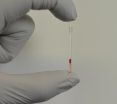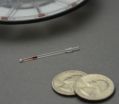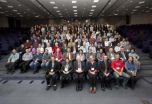(Press-News.org) Within minutes after birth, every child in the U.S. undergoes a battery of tests designed to diagnose a host of conditions, including sickle cell disease. Thousands of children born in the developing world, however, aren't so lucky, meaning many suffer and die from the disease each year.
A.J. Kumar hopes to put a halt to at least some of those deaths.
A Post-Doctoral Fellow in Chemistry and Chemical Biology working in the lab of George Whitesides, the Woodford L. and Ann A. Flowers University Professor, Kumar and colleagues, including other co-authors, have developed a new test for sickle cell disease that provides results in just 12 minutes and costs as little as 50 cents – far faster and cheaper than other tests. The test is described in a paper published this week in the Proceedings of the National Academy of Sciences.
"The tests we have today work great, they have a very high sensitivity," Kumar said. "But the equipment needed to run them costs in the tens of thousands of dollars, and they take hours to run. That's not amenable to rural clinics, or even some cities where the medical infrastructure isn't up to the standards we see in the U.S. That's where having a rapid, low-cost test becomes important and this paper shows such a test can potentially work."
When run against more than 50 clinical samples – 26 positive and 26 negative – the new test showed good sensitivity and specificity for the disease, Kumar said, so the early evidence is promising, but additional testing will be needed to determine whether the test is truly accurate enough to use in the field.
The test designed by Kumar is deceptively simple, and works by connecting two ideas scientists have understood for decades.
The first is the notion that blood cells affected by the disease are denser than normal cells, and the second is that many polymers, when mixed in water, automatically separate into layers ordered by density.
Conventional methods to separate cells by density relied on layering liquids with different density by hand. The insight, arrived at by Charles Mace (now at Tufts) and Kumar, was that the self-forming layers could be used to separate cells, such as red blood cells, by density.
"When you mix the polymers with water, they separate just like oil and water," he said. "Even if you mix it up, it will still come back to those layers."
It wasn't until a chance meeting with Dr. Thomas Stossel, however, that Kumar believed the technology might have a real impact on sickle cell disease.
"Initially, we started off working on malaria, because we thought when parasites invaded the cells, it would change their density," he said. "But when I met Tom Stossel on a panel at the Harvard Medical School, he said, 'You need to work on sickle cell.' He's a hematologist by training and has been working with a non-profit in Zambia for the past decade, so he's seen the need and the lack of a diagnostic tool."
When Kumar and colleagues ran tests with infected blood, their results were unmistakable. While healthy red blood cells settled in the tubes at specific levels, the dense cells from blood infected with sickle cell settled in a band significantly lower. The band of red cells could clearly be seen by eye.
Just showing that the test worked, however, wasn't enough.
"We wanted to make the test as simple as possible," Kumar explained. "The idea was to make it something you could run from just a finger prick. Because these gradients assemble on their own, that meant we could make them in whatever volume we wanted, even a small capillary tube."
The design the team eventually settled on is barely larger than a toothpick. In the field, Kumar said, running the test is as simple as uncapping the tube, pricking a patient's finger and allowing the blood to wick into the tube.
While further study is needed to determine how accurate and effective the test may be, Kumar said stopping even a few sickle-cell-related deaths would represent a victory.
"The best way to state it is in terms of the actual problem," he said. "About 300,000 children are born every year with sickle cell disease, and the vast majority – about 80 to 90 percent – are in either Africa or India, where for the most part, they aren't going to get access to the current screening tests.
"There were studies recently that showed in sub-Saharan Africa, between 50 and 90 percent of the children born with sickle cell disease die before the age of 5," he continued. "Whereas in the U.S. people don't die from this disease as children, they can still live a full life. So my hope is that if this test is effective, it can make some small dent in those numbers."
INFORMATION:
Faster, cheaper tests for sickle cell
Newly developed test can identify sickle cell disease in minutes and could be used in rural clinics around the globe
2014-09-01
ELSE PRESS RELEASES FROM THIS DATE:
Training your brain to prefer healthy foods
2014-09-01
BOSTON (September 1, 2014, 10:20 AM EDT) — It may be possible to train the brain to prefer healthy low-calorie foods over unhealthy higher-calorie foods, according to new research by scientists at the Jean Mayer USDA Human Nutrition Research Center on Aging (USDA HNRCA) at Tufts University and at Massachusetts General Hospital. Published online today in the journal Nutrition & Diabetes, a brain scan study in adult men and women suggests that it is possible to reverse the addictive power of unhealthy food while also increasing preference for healthy foods.
"We don't start ...
Fruit consumption cuts CVD risk by up to 40 percent
2014-09-01
Barcelona, Spain – Monday 1 September 2014: Daily fruit consumption cuts the risk of cardiovascular disease (CVD) by up to 40%, according to research presented at ESC Congress today by Dr Huaidong Du from Oxford, UK. The findings from the seven year follow-up study of nearly 0.5 million people in the China Kadoorie Biobank found that the more fruit people ate, the more their risk of CVD declined.
Dr Du said: "CVD, including ischaemic heart disease (IHD) and stroke, is the leading cause of death worldwide. Improving diet and lifestyle is critical for CVD risk reduction ...
Permanent AF doubles risk of stroke compared to paroxysmal AF
2014-09-01
Barcelona, Spain – Monday 1 September 2014: Permanent atrial fibrillation (AF) doubles the risk of stroke compared to paroxysmal AF, according to research in more than 6 000 patients presented at ESC Congress today by Dr Thomas Vanassche from Belgium. The findings suggest that a simple clinical assessment of the type of AF can help doctors to better estimate stroke risk.
Ischaemic stroke is the second cause of death in the EU, accounting for over a million deaths and many more disabled patients each year. Annual direct health care costs amount to more than €20 billion. ...
A nucleotide change could initiate fragile X syndrome
2014-09-01
Researchers reveal how the alteration of a single nucleotide—the basic building block of DNA—could initiate fragile X syndrome, the most common inherited form of intellectual disability. The study appears in The Journal of Cell Biology.
Fragile X syndrome is caused by a defect in a gene on the X chromosome called fragile X mental retardation 1 (FMR1). Around 1 in 230 women and 1 in 360 men carry a so-called premutation, in which a series of DNA repeats at one end of the FMR1 gene is slightly longer than normal. These repeats are prone to even further expansion when ...
Scientists call for investigation of mysterious cloud-like collections in cells
2014-09-01
WASHINGTON — About 50 years ago, electron microscopy revealed the presence of tiny blob-like structures that form inside cells, move around and disappear. But scientists still don't know what they do — even though these shifting cloud-like collections of proteins are believed to be crucial to the life of a cell, and therefore could offer a new approach to disease treatment.
In the Journal of Cell Biology, two researchers are issuing a call to investigators from various backgrounds, from biophysics to cell biology, to focus their attention on the role of these formations— ...
Zooming in for a safe flight
2014-09-01
As nocturnal animals, bats are perfectly adapted to a life without light. They emit echolocation sounds and use the delay between the reflected echoes to measure distance to obstacles or prey. In their brains, they have a spatial map representing different echo delays. A study carried out by researchers at Technische Universität München (TUM) has shown for the first time that this map dynamically adapts to external factors.
Closer objects appear larger
When a bat flies in too close to an object, the number of activated neurons in its brain increases. As a result, ...
Week-long meeting on naming algae, fungi, and plants recorded for posterity
2014-09-01
The week-long discussions and decisions of the Nomenclature Section of the XVIII International Botanical Congress took place in Melbourne, Australia in July 2011. This meeting is held every six years and it is where the world's premier experts on the rules for naming algae, fungi and plants get together to debate and update the rule book for naming the organisms they study. This is the primary product of the meeting, the International Code of Nomenclature for algae, fungi, and plants, which was published in 2012. The other important product is the official report for the ...
Scientists get set for simulated nuclear inspection
2014-09-01
Some 40 scientists and technicians from around the world will descend on Jordan in November to take part in a simulated on-site inspection of a suspected nuclear test site on the banks of the Dead Sea.
Playing the part of inspectors, the experts will have access to a wide range of sensor technologies to look for signs of whether a nuclear explosion has taken place. At the same time, other role-players representing the state under inspection will try to put them off their scent.
The aim of this elaborate exercise, as science writer Edwin Cartlidge explains in this month's ...
Invisible blood in urine may indicate bladder cancer
2014-09-01
New research which finds that invisible blood in urine may be an early warning sign of bladder cancer is likely to shape guidelines for clinicians.
Scientists at the University of Exeter Medical School found that one in 60 people over the age of 60 who had invisible blood in their urine (identified by their GP testing their urine) transpired to have bladder cancer. The figure was around half those who had visible blood in their urine – the best known indicator of bladder cancer. However, it was still higher than figures for other potential symptoms of bladder cancer ...
Sugar substance 'kills' good HDL cholesterol, new research finds
2014-09-01
Scientists at the University of Warwick have discovered that 'good' cholesterol is turned 'bad' by a sugar-derived substance.
The substance, methylglyoxal - MG, was found to damage 'good' HDL cholesterol, which removes excess levels of bad cholesterol from the body.
Low levels of HDL, High Density Lipoprotein, are closely linked to heart disease, with increased levels of MG being common in the elderly and those with diabetes or kidney problems.
Supported by funding from the British Heart Foundation (BHF) and published in Nutrition and Diabetes, the researchers ...
LAST 30 PRESS RELEASES:
Tracing the quick synthesis of an industrially important catalyst
New software sheds light on cancer’s hidden genetic networks
UT Health San Antonio awarded $3 million in CPRIT grants to bolster cancer research and prevention efforts in South Texas
Third symposium spotlights global challenge of new contaminants in China’s fight against pollution
From straw to soil harmony: International team reveals how biochar supercharges carbon-smart farming
Myeloma: How AI is redrawing the map of cancer care
Manhattan E. Charurat, Ph.D., MHS invested as the Homer and Martha Gudelsky Distinguished Professor in Medicine at the University of Maryland School of Medicine
Insilico Medicine’s Pharma.AI Q4 Winter Launch Recap: Revolutionizing drug discovery with cutting-edge AI innovations, accelerating the path to pharmaceutical superintelligence
Nanoplastics have diet-dependent impacts on digestive system health
Brain neuron death occurs throughout life and increases with age, a natural human protein drug may halt neuron death in Alzheimer’s disease
SPIE and CLP announce the recipients of the 2025 Advanced Photonics Young Innovator Award
Lessons from the Caldor Fire’s Christmas Valley ‘Miracle’
Ant societies rose by trading individual protection for collective power
Research reveals how ancient viral DNA shapes early embryonic development
A molecular gatekeeper that controls protein synthesis
New ‘cloaking device’ concept to shield sensitive tech from magnetic fields
Researchers show impact of mountain building and climate change on alpine biodiversity
Study models the transition from Neanderthals to modern humans in Europe
University of Phoenix College of Doctoral Studies releases white paper on AI-driven skilling to reduce burnout and restore worker autonomy
AIs fail at the game of visual “telephone”
The levers for a sustainable food system
Potential changes in US homelessness by ending federal support for housing first programs
Vulnerability of large language models to prompt injection when providing medical advice
Researchers develop new system for high-energy-density, long-life, multi-electron transfer bromine-based flow batteries
Ending federal support for housing first programs could increase U.S. homelessness by 5% in one year, new JAMA study finds
New research uncovers molecular ‘safety switch’ shielding cancers from immune attack
Bacteria resisting viral infection can still sink carbon to ocean floor
Younger biological age may increase depression risk in older women during COVID-19
Bharat Innovates 2026 National Basecamp Showcases India’s Most Promising Deep-Tech Ventures
Here’s what determines whether your income level rises or falls
[Press-News.org] Faster, cheaper tests for sickle cellNewly developed test can identify sickle cell disease in minutes and could be used in rural clinics around the globe






